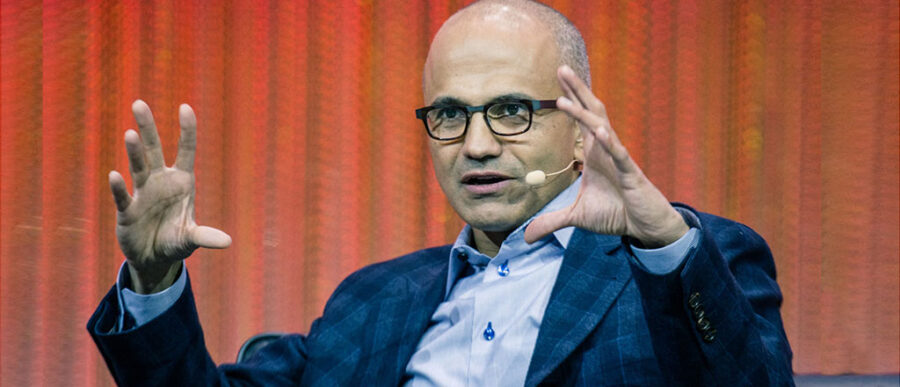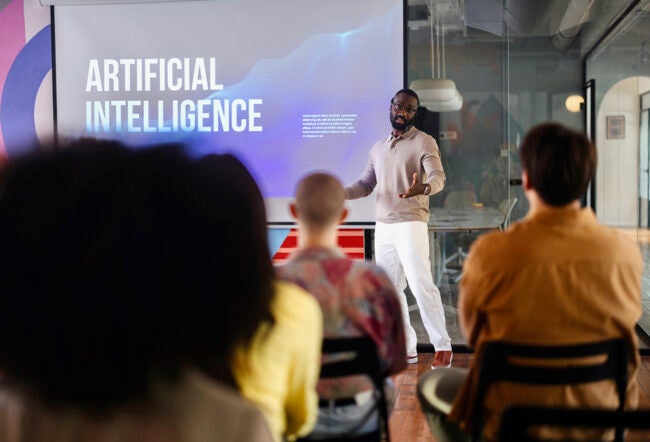Microsoft CEO Satya Nadella will hit the six-month mark of his tenure on August 4 and so far, many observers have given him high marks for communicating the company’s strategy, putting his own stamp on the giant software maker and embarking on a restructuring effort that has been well received. The harder part, however, will be executing and specifically defining Microsoft’s broader goals, which revolve around being “the productivity and platform company for the mobile-first and cloud-first world,” as Nadella wrote in a 3,200-word memo to employees.
The memo was released as the company announced that it plans to cut 18,000 jobs — about 14% of its workforce — over the next year. Most of the cuts are related to integrating Nokia’s handset business, which the Redmond, Wash.-based company bought in April. “Nadella has a broad mandate and he’s empowered to lead change,” says Wharton management professor David Hsu. “He has set the strategy and then focused on operational efficiency.”
In the memo sent on July 10, Nadella set a course for Microsoft, outlining the company’s view of technology and set his strategy apart from his predecessor, Steve Ballmer. Nadella, an insider who took over as CEO February 4 and joined the company in 1992, ran Microsoft’s cloud efforts as well as its server and tools division, which is the most profitable in the company.
Nadella views Microsoft as a company that is more than just Windows and PCs. After all, Microsoft has launched its Office word processing suite on Apple’s iOS and iPad and plans to create versions of its productivity software on Android. Those versions are landing before Microsoft creates a version of Office for Windows-based tablets and phones.
Nadella also wrote that Microsoft’s historical vision of putting a PC on every desk won’t work in the future. “Devices and services” was Ballmer’s mantra and was “helpful in starting our transformation,” but not enough to set the company apart from competitors, Nadella noted.
“We will reinvent productivity to empower every person and every organization on the planet to do more and achieve more,” wrote Nadella. “We think about productivity for people, teams and the business processes of entire organizations as one interconnected digital substrate. We also think about interconnected platforms for individuals, IT and developers.”
If Microsoft wants to keep its status as a key player in the tech sector, the company has to refocus on the cloud and mobile, according to Lawrence Hrebiniak, an emeritus management professor at Wharton. But while Microsoft dominated the PC market with Windows and other software, the company “doesn’t have a lead in mobile and cloud,” Hrebiniak notes. “It’s a tough market to come from behind with competition such as IBM, Apple, Google and Amazon.”
“Nadella has a broad mandate and he’s empowered to lead change. He has set the strategy and then focused on operational efficiency.” –David Hsu
Nadella added in his memo that the Xbox video gaming platform is important to Microsoft, even though it doesn’t neatly fit into the productivity-focused strategy. “As a large company, I think it’s critical to define the core, but it’s important to make smart choices on other businesses in which we can have fundamental impact and success” he wrote. “The single biggest digital life category, measured in both time and money spent, in a mobile-first world is gaming. We are fortunate to have Xbox in our family to go after this opportunity with unique and bold innovation.”
Scaling Back
In addition to the layoffs announced July 17 — which include 12,500 positions related to the Nokia device business — Microsoft also plans to scale back operations in China and move manufacturing to Vietnam, where costs are cheaper. A factory worker in Hanoi makes $145 a month, compared with $466 a month in Beijing, according to the Japan External Trade Organization (JETRO.)
Hsu, however, says that the other nearly 6,000 Microsoft employees affected by the restructuring — managers, engineers and product-focused workers — may be more important to how the company runs. Ballmer had more management layers and Nadella is reversing that structure to make Microsoft more nimble, Hsu notes. “Every team across Microsoft must find ways to simplify and move faster, more efficiently,” Nadella wrote in his memo. “We will increase the fluidity of information and ideas by taking actions to flatten the organization and develop leaner business processes.”
In an interview last week on the Knowledge at Wharton show on Wharton Business Radio on SiriusXM, Wharton legal studies and business ethics professor Kevin Werbach said that Nadella has to put his own stamp on the company given that it was previously run by two co-founders, Bill Gates and Ballmer, adding that Nadella has had a honeymoon period but now faces “real significant challenges” that need to be addressed.
Wall Street analysts rallied around Nadella’s larger-than-expected restructuring. “The ‘insider’ label that much of the press put on Nadella clearly underestimated his willingness to put his own stamp on Microsoft as this decision and his letter to employees demonstrates,” Evercore analyst Kirk Materne said in a research note.
FBR analyst Daniel Ives wrote in a research note that Nadella is partially unraveling what could have been a poor decision to acquire Nokia. “While the cuts will be painful for employees, they were necessary, in our view, and speak to Nadella’s attempt at cleaning up part of the mess that Ballmer left behind in Redmond,” said Ives who on the Knowledge at Wharton SirisuXM show likened Nadella’s moves to create a clear slate after a 10-year party under Ballmer.
Waiting for Details
“Arguably everything can fall under productivity and platform,” says Hsu. “Nadella’s challenge will be communicating what exactly productivity and platform means and aligning the organization behind it. He will have to be much more specific. At this stage, all he has is a high-level vision.”
Hrebiniak adds that if Nadella doesn’t get more specific quickly about what a productivity and platform focus means for Microsoft’s various products, Wall Street could become impatient in a hurry. In addition, employees need more detail on how their work and processes will change under the new regime.
In his memo, Nadella promised Microsoft “will modernize our engineering processes to be customer-obsessed, data-driven, speed-oriented and quality-focused.” That goal “sounds wonderful,” Hrebiniak notes, and moves away from the old Microsoft, but implementing those changes will be difficult. “He’s saying the right things though,” says Hrebiniak. “Nadella will have to offer more specifics pretty quickly. I need to know more. The core statement is pretty general.
Werbach said on the Knowledge at Wharton show that Nadella could struggle to communicate his vision, noting that in a company with more than 100,000 employees, it’s hard to have visibility and influence.
“It’s a tough market to come from behind with competition such as IBM, Apple, Google and Amazon.” –Lawrence Hrebiniak
On Microsoft’s fiscal fourth quarter earnings conference call July 22, Nadella elaborated somewhat on how the company’s focus on productivity and platforms would drive future investments. “Mobility for us goes beyond just devices. While we are certainly focused on building great phones and tablets, we think of mobility more expansively,” said Nadella. “We think the opportunity … comes from running our productivity experiences on Windows, iOS and Android devices.”
Regarding platforms, Nadella said Microsoft views its software as a cloud operating system that can be used to run data centers or be delivered as a services. “We have a specific goal for multiple Microsoft applications to be available on every home screen,” Nadella noted, adding that the company “will get crystal clear on the core businesses” that support Microsoft’s mission and make hard choices about future investment.
Culture Challenges Ahead?
The key challenge for Nadella, Werbach said, is to successfully outline a message at a high level, but then have it filter through the multi-pronged organization to jump-start Microsoft’s growth. “Microsoft is a tough company, and it’s hard to rise to the top and stay at the top and be well liked,” Werbach noted. “Internally, [Nadella] has a strong reputation. [Employees] are the community he needs to win over.”
To truly compete with the likes of Apple and Google, Nadella will have to simplify and restructure to make Microsoft leaner and more efficient, says Hrebiniak. The Microsoft CEO will also have to answer a lot of questions. For example: “What does modernizing engineering mean exactly? How do you innovate?” Hrebiniak notes.
Meanwhile, Microsoft’s employees will have to face some potential insecurity for the foreseeable future. “The 5,500 redundancies at the management level at Microsoft are where the uncertainty is,” says Hsu, who adds that Nadella will have to boost morale after the cuts. Once the layoffs are complete, and the new company structure takes shape, Microsoft will have to show workers “how productivity and platform [as a strategy] is different from what the company has done before,” Hsu notes. “It’s clear that it won’t be business as usual, but anytime you’re undoing strategy there will be people wondering if you’ll pivot again.”
Another item on Nadella’s to-do list is to craft a winning plan for gaining ground in the mobile sector. “Microsoft will get into the cloud OK, but mobile hasn’t been strong at all. Playing catch up is against form at Microsoft,” says Hrebiniak.
Werbach noted that Microsoft is losing out to Android and Apple and is currently a distant No. 3 player. “Microsoft needs to be strong” in mobile, said Werbach, adding that it’s unclear whether retooling the Nokia product line to be smaller and more focused on will help.
One potential differentiator for Microsoft would be to focus on the future of mobile instead of the current, smartphone-focused market, Werbach suggested. Apple’s iPhone was launched just seven years ago, he noted, and the tablet market matured quickly. Microsoft could focus on wearables or an emerging category. “There are big challenges, but there’s also the possibility to be in a strong position in the future,” said Werbach. “It’s not like Microsoft is going away.”
“Internally, [Nadella] has a strong reputation. [Employees] are the community he needs to win over.” –Kevin Werbach
Xbox’s Role
Microsoft’s core strengths — a strong enterprise business and a fast-growing cloud platform called Azure — illustrate how the overall business can operate. However, Nadella will also have to be disciplined and rid Microsoft of assets that may not align under the productivity and platform strategy, Wharton experts say. “A bigger issue may be that Microsoft has an old model, and businesses like Bing, video calling and Web advertising. Some of these things should go,” Hrebiniak notes.
Despite Nadella’s comments in his memo, Hrebiniak thinks Xbox is a distraction for Microsoft. He adds that he was surprised that Nadella defended the role of Xbox and tried to include it into the productivity and platform strategy.
According to Hrebiniak, the argument that Xbox technologies flow into other products from Microsoft makes some sense, but the company could spin off some portion of the division under independent management and still maintain technology connections.
Werbach, however, said Xbox is a critical way for Microsoft to become a leading player in the digital living room. “Xbox is important as a beachhead to the living room. It’s a big opportunity, but challenging and requires a different skill set. Xbox is a marker that it’s a possibility for Microsoft to have an explosive growth opportunity, but it’s a hard nut to crack.”
Ultimately, Nadella will have to formulate a plan for Xbox’s role inside Microsoft and possibly divest assets that don’t fit with the broader strategy. One thing is certain: Nadella has Microsoft’s vast cash pile and mandate at his disposal to bring about change. Werbach noted that Microsoft is at a fork in the road: It must find ways to grow and change the world or stagnate. Microsoft’s current challenge “is a watershed in the tech industry,” Werbach said.



